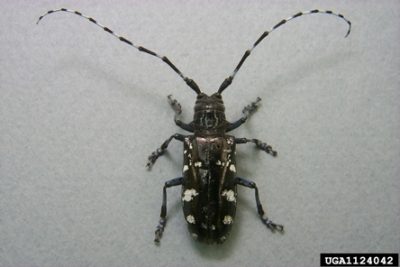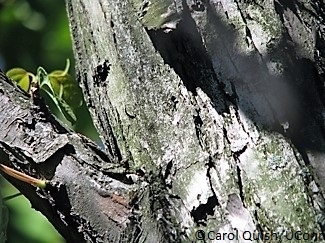Anoplophora glabripennis

The invasive Asian longhorned beetle (ALB), Anoplophora glabripennis, has been discovered attacking trees in the United States. The ALB arrived in the United States within hardwoods cut into crates and pallets and used to import goods from Asian countries. There are currently known infestations being eradicated in New York, Illinois, and New Jersey. Damage from these infestations has resulted in the removal of more than 30,000 trees and costs in excess of $269 million since the discovery of the infestations in 1996. The ALB was recently confirmed in Worcester, Massachusetts. The proximity to Connecticut puts our forests at risk. The ALB is a serious threat to U.S. trees. The ALB has the potential to wreak havoc nationwide, affecting such industries as lumber, maple syrup, nursery, and tourism.
Host Plants
This beetle is a serious pest in China where it kills hardwood trees in roadside plantings, shelterbelts, and plantations. In the United States the beetle prefers maple species (Acer spp.), including boxelder, Norway, red, silver, and sugar maples. Other known hosts are alders, birches, elms, horse chestnut, poplars, and willows. A complete list of host trees in the U.S. has not been determined. In addition to the states where eradication measures have been implemented, the ALB has been reported in the past decade in warehouses in California, Alabama, Florida, Indiana, Michigan, North Carolina, Ohio, Pennsylvania, South Carolina, Texas, Washington, and Wisconsin.
Life History
The ALB has one generation per year. Adult beetles are usually present from July to October, but can be found later in the fall if temperatures are warm. Adults usually stay on the trees from which they emerged or they may disperse short distances to a new host to feed and reproduce. The adult beetle is about 1 to 1.5 inches long. Shiny black with white spots, it has exceptionally long antennae that are banded with black and white. The elongated feet are black with a whitish-blue upper surface. Although its size and large mandibles cause it to appear threatening, the beetle is harmless to humans and pets. Each female can lay up to 160 eggs. Single eggs are laid in chewed out oval to round pits in the bark. The eggs hatch in 10-15 days and the white, worm-like larvae tunnel under the bark and into the wood where they eventually pupate. The adults emerge from pupation sites by boring a tunnel in the wood and creating a 3/8” or larger round exit hole on the trunk or branches.
Signs of Infestation
Signs of infestation by the ALB include the presence of adult beetles, egg deposit sites, piles of frass at the base of infested trees and in branch crotches, sap leaking from wounds in the trees, and exit holes (see images below) created by the emerging adults. Leaf symptoms show up when the immature insects, growing inside the tree, have bored through tissues that carry water from tree roots and nutrients from the leafy canopy above. This may include unseasonable yellowing and drooping of leaves when the weather has not been especially dry. Once the infestation is sufficiently advanced, the infested branch or the entire tree will die.


Control Measures
Although treatments exist to control ALB-infested cargo, the ALB is not easily controlled once it is introduced into the environment. Because most of the beetle’s life is spent deep within the heartwood of host trees, it is difficult to control using contact insecticides. Although costly and undesirable, the only assured method of eliminating the beetle is to cut and chip or burn infested trees and replace them with a non-host species. Scientists continue to experiment with new chemicals, application methods, biocontrol methods, and devices to detect ALB-infested trees. Restrictions on imported solid wood packing material have also been implemented to help prevent future infestations. Thorough surveys are conducted by trained inspectors in high-risk areas where potentially infested cargo has been imported.
Residents suspecting they have seen the ALB should report their findings to the Connecticut Agricultural Experiment Station at (203)974-8474 or (203)974-8485. Residents can also report sightings to the U.S. Department of Agriculture, Animal and Plant Health Inspection Service (APHIS).
For more information and to view images of the ALB visit the National Invasive Species Information Center.
Despite good cultural practices, pests and diseases at times may appear. Chemical control should be used only after all other methods have failed.
For pesticide information or other questions please call toll free: 877-486-6271.
References: Connecticut Department of Environmental Protection Press Release “DEP and Connecticut Agricultural Experiment Station Respond to Presenced of Asian Longhorn Beetle in Worcester, MA”. August 11, 2008. USDA APHIS Pest Alert Fact Sheet number NA-PR-01-99GEN “Asian Longhorned Beetle (Anoplophora glabripennis): A New Introduction”. Revised September 2002. USDA APHIS Plant Protection and Quarantine Factsheet “Asian Longhorned Beetle: Questions and Answers”. May 2007.
Prepared by Joan E. Allen, 2008 by UConn Home and Garden Education Center.
Revised by UConn Home and Garden Education Center 2019.